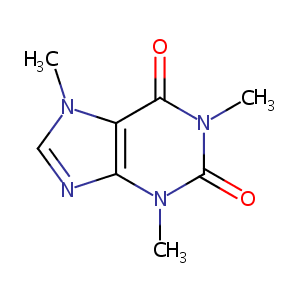| 1 |
ClinicalTrials.gov (NCT00430170) Does Caffeine Reduce Dipyridamole-Induced Protection Against Ischemia-Reperfusion Injury?
|
| 2 |
Caffeine FDA Label
|
| 3 |
URL: http://www.guidetopharmacology.org Nucleic Acids Res. 2015 Oct 12. pii: gkv1037. The IUPHAR/BPS Guide to PHARMACOLOGY in 2016: towards curated quantitative interactions between 1300 protein targets and 6000 ligands. (Ligand id: 407).
|
| 4 |
Dipyridamole FDA Label
|
| 5 |
URL: http://www.guidetopharmacology.org Nucleic Acids Res. 2015 Oct 12. pii: gkv1037. The IUPHAR/BPS Guide to PHARMACOLOGY in 2016: towards curated quantitative interactions between 1300 protein targets and 6000 ligands. (Ligand id: 4807).
|
| 6 |
Caffeine as a psychomotor stimulant: mechanism of action. Cell Mol Life Sci. 2004 Apr;61(7-8):857-72.
|
| 7 |
Effect of cytochrome P450 (CYP) inducers on caffeine metabolism in the rat. Pharmacol Rep. 2007 May-Jun;59(3):296-305.
|
| 8 |
Substrates, inducers, inhibitors and structure-activity relationships of human Cytochrome P450 2C9 and implications in drug development. Curr Med Chem. 2009;16(27):3480-675.
|
| 9 |
A population and family study of N-acetyltransferase using caffeine urinary metabolites. Clin Pharmacol Ther. 1993 Aug;54(2):134-41.
|
| 10 |
Determinants of interindividual variability and extent of CYP2D6 and CYP1A2 inhibition by paroxetine and fluvoxamine in vivo. J Clin Psychopharmacol. 1998 Jun;18(3):198-207.
|
| 11 |
CYP2E1 active site residues in substrate recognition sequence 5 identified by photoaffinity labeling and homology modeling. Arch Biochem Biophys. 2007 Mar 1;459(1):59-69.
|
| 12 |
PharmGKB summary: caffeine pathway. Pharmacogenet Genomics. 2012 May;22(5):389-95.
|
| 13 |
Monkey liver cytochrome P450 2C9 is involved in caffeine 7-N-demethylation to form theophylline. Xenobiotica. 2013 Dec;43(12):1037-42.
|
| 14 |
Oxidation of xenobiotics by recombinant human cytochrome P450 1B1. Drug Metab Dispos. 1997 May;25(5):617-22.
|
| 15 |
Coffee, CYP1A2 genotype, and risk of myocardial infarction. JAMA. 2006 Mar 8;295(10):1135-41. doi: 10.1001/jama.295.10.1135.
|
| 16 |
ADReCS-Target: target profiles for aiding drug safety research and application. Nucleic Acids Res. 2018 Jan 4;46(D1):D911-D917. doi: 10.1093/nar/gkx899.
|
| 17 |
Adenosine up-regulates vascular endothelial growth factor in human macrophages. Biochem Biophys Res Commun. 2010 Feb 12;392(3):351-6. doi: 10.1016/j.bbrc.2010.01.023. Epub 2010 Jan 11.
|
| 18 |
Anti-platelet therapy: phosphodiesterase inhibitors.Br J Clin Pharmacol.2011 Oct;72(4):634-46.
|
| 19 |
Improving the prediction of the brain disposition for orally administered drugs using BDDCS. Adv Drug Deliv Rev. 2012 Jan;64(1):95-109.
|
| 20 |
ABCG2: a perspective. Adv Drug Deliv Rev. 2009 Jan 31;61(1):3-13.
|
| 21 |
Cyclic GMP mediates apoptosis induced by sulindac derivatives via activation of c-Jun NH2-terminal kinase 1. Clin Cancer Res. 2000 Oct;6(10):4136-41.
|
| 22 |
A multifactorial approach to hepatobiliary transporter assessment enables improved therapeutic compound development. Toxicol Sci. 2013 Nov;136(1):216-41.
|
| 23 |
Expression of multidrug transporter MRP4/ABCC4 is a marker of poor prognosis in neuroblastoma and confers resistance to irinotecan in vitro. Mol Cancer Ther. 2005 Apr;4(4):547-53. doi: 10.1158/1535-7163.MCT-04-0161.
|
| 24 |
Dipyridamole enhances tissue plasminogen activator release by brain capillary endothelial cells. Thromb Res. 2005;115(5):435-8. doi: 10.1016/j.thromres.2004.10.001. Epub 2004 Nov 5.
|
| 25 |
Selection of drugs to test the specificity of the Tg.AC assay by screening for induction of the gadd153 promoter in vitro. Toxicol Sci. 2003 Aug;74(2):260-70. doi: 10.1093/toxsci/kfg113. Epub 2003 May 2.
|
| 26 |
Binding of disopyramide, methadone, dipyridamole, chlorpromazine, lignocaine and progesterone to the two main genetic variants of human alpha 1-acid glycoprotein: evidence for drug-binding differences between the variants and for the presence of two separate drug-binding sites on alpha 1-acid glycoprotein. Pharmacogenetics. 1996 Oct;6(5):403-15. doi: 10.1097/00008571-199610000-00004.
|
| 27 |
Identification of environmental chemicals that activate p53 signaling after in vitro metabolic activation. Arch Toxicol. 2022 Jul;96(7):1975-1987. doi: 10.1007/s00204-022-03291-5. Epub 2022 Apr 18.
|
| 28 |
Impact of adenosine receptor signaling and metabolism on pathophysiology in patients with chronic heart failure. Hypertens Res. 2007 Sep;30(9):781-7. doi: 10.1291/hypres.30.781.
|
| 29 |
The effect of dipyridamole on vascular cell-derived reactive oxygen species. J Pharmacol Exp Ther. 2005 Nov;315(2):494-500. doi: 10.1124/jpet.105.089987. Epub 2005 Jul 26.
|
| 30 |
Palmitate increases the susceptibility of cells to drug-induced toxicity: an in vitro method to identify drugs with potential contraindications in patients with metabolic disease. Toxicol Sci. 2012 Oct;129(2):346-62. doi: 10.1093/toxsci/kfs208. Epub 2012 Jun 14.
|
| 31 |
Inhibiting the calcineurin-NFAT (nuclear factor of activated T cells) signaling pathway with a regulator of calcineurin-derived peptide without affecting general calcineurin phosphatase activity. J Biol Chem. 2009 Apr 3;284(14):9394-401. doi: 10.1074/jbc.M805889200. Epub 2009 Feb 3.
|
| 32 |
Effects of phosphodiesterase (PDE) inhibitors on human ether-a-go-go related gene (hERG) channel activity. J Appl Toxicol. 2007 Jan-Feb;27(1):78-85. doi: 10.1002/jat.1201.
|
| 33 |
Intracellularly transported adenosine induces apoptosis in HuH-7 human hepatoma cells by downregulating c-FLIP expression causing caspase-3/-8 activation. Biochem Pharmacol. 2007 May 15;73(10):1665-75. doi: 10.1016/j.bcp.2007.01.020. Epub 2007 Jan 18.
|
| 34 |
New role of the human equilibrative nucleoside transporter 1 (hENT1) in epithelial-to-mesenchymal transition in renal tubular cells. J Cell Physiol. 2012 Apr;227(4):1521-8. doi: 10.1002/jcp.22869.
|
|
|
|
|
|
|


